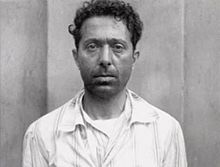Miguel Arcángel Roscigna
This article may be expanded with text translated from the corresponding article in Spanish. (September 2021) Click [show] for important translation instructions.
|
This article needs additional citations for verification. (August 2021) |
Miguel Arcángel Roscigna | |
|---|---|
 | |
| Born | 1891 Buenos Aires, Argentina |
| Disappeared | 1936, now deceased |
| Nationality | Argentine |
| Known for | criminal pushing for 'expropiative anarchism |
| Movement |
|
| Partner(s) | Victoria Romano |
Miguel Arcángel Roscigna was a blacksmith, politician, fugitive, and a militant Argentine anarchist[1] who was notable for his activity in Argentine expropriative anarchism.
Early life[]
Miguel Arcángel Roscigna was born in 1891 in Buenos Aires in the family of Italian immigrants whose names were Vicente Roscigno and Filomena Del Mastro.
After he had completed elementary school he became an apprentice welder and later became an outstanding artistic blacksmith, which led to him taking part in the construction of the Barolo Palace, which is in the city of Buenos Aires the city where he was born.
Life events[]
In 1909, following the death of Ramón Falcón, responsible for the "Red Week" massacre, at the hands of the anarchist Simon Radowitzky, he had started getting more interested in anarchism and socialism. In 1914, he married Victoria Romano.
The Patagonian Rebellion[]
With the events of the Patagonian Revellion that caused the secession of Patagonia from Argentina, Roscigna moved there and became prominent in one of the FOP's main factions, the USA, specifically in the radical wing alongside Severino Di Giovanni.
Life as a politician[]
Roscigna became a member of political party Unión de Sindicatos Argentinos, (Union of Argentine Syndicates) and had deemed current actions as insufficient for the release of prisoners, Roscigna decided towards a more violent approach, expropriative anarchism. In November of 1918 he traveled to the Ushuaia Prison where Simon Radowitzky was serving his sentence. Although Radowitzky managed to escape initially, he was later captured and returned to prison.[2]
Time as a fugitive, capture, and disappearance[]
Roscigna was wanted for crimes and had fled Argentina. Roscigna was later sent to prison in 1927 after being captured. After Roscigna was released from prison, he disappeared in 1936,[3] and was never seen or heard from again and is presumed deceased.
See also[]
- Illegalism
- List of people who disappeared
- Severino Di Giovanni
References[]
- ^ Durruti in the Spanish Revolution ISBN 978-0-914-15620-8 p. 85
- ^ The Anarchist Expropriators: Buenaventura Durruti and Argentina's Working-Class Robin Hoods. AK Press. ISBN 978-1-84935-224-6.
- ^ "A History of Expropriative Anarchism". theanarchistlibrary.org. 1 January 2014. Retrieved 20 August 2021.
Further reading[]
- Bayer, Osvaldo (2015). The Anarchist Expropriators: Buenaventura Durruti and Argentina's Working-Class Robin Hoods. Translated by Sharkey, Paul. AK Press. ISBN 978-1-84935-224-6.
- Caimari, Lila (December 6, 2016). While the City Sleeps: A History of Pistoleros, Policemen, and the Crime Beat in Buenos Aires before Perón (Volume 2) (Violence in Latin American History). University of California Press. ISBN 978-0-520-28944-4.
| Part of a series on |
| Anarchism |
|---|
 |
|
|
- 1891 births
- 1930s missing person cases
- 1931 deaths
- Argentine anti-fascists
- Argentine anarchists
- Extrajudicial killings
- Fugitives
- Illegalists
- Insurrectionary anarchists
- Enforced disappearances in Argentina
- Missing person cases in Argentina